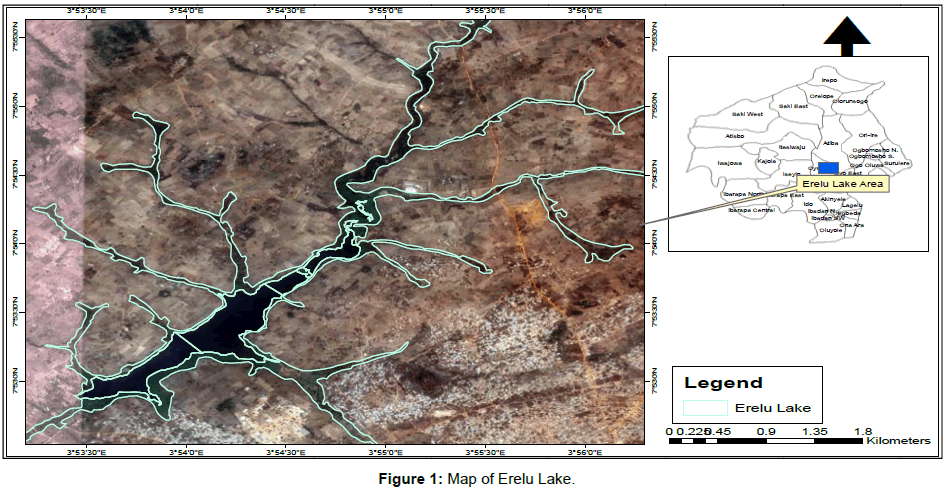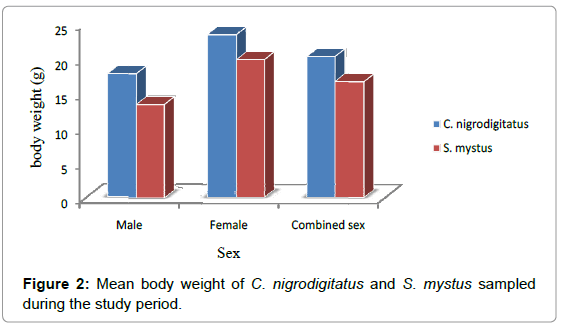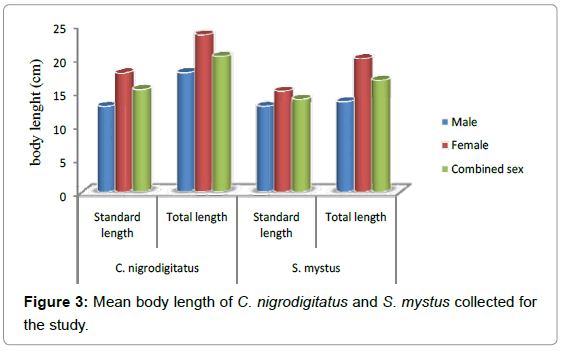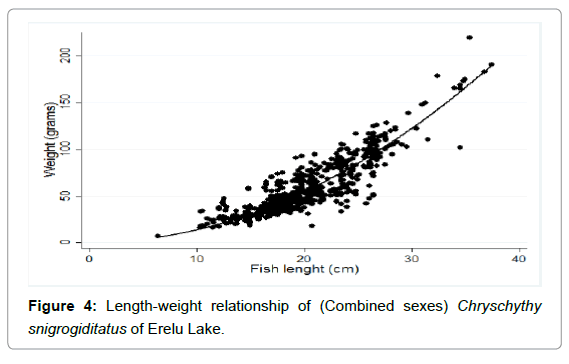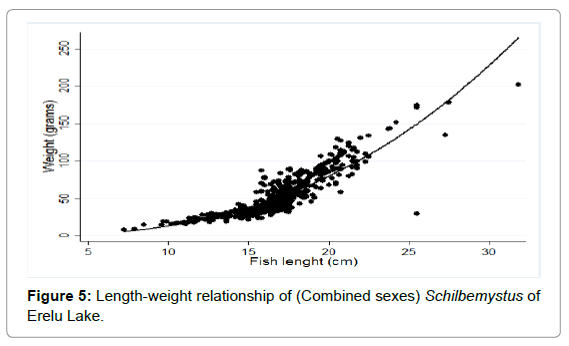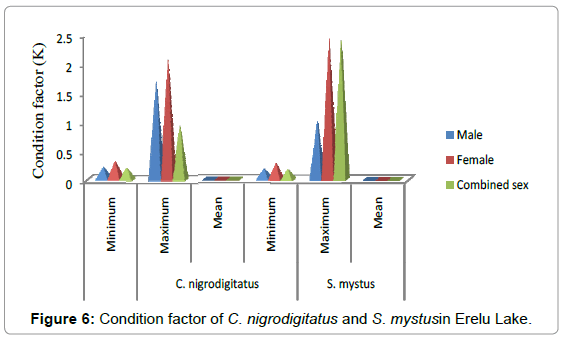Research Article Open Access
Length-weight Relationship and Condition factor of Chrysichythys nigrodigitatus and Schilbe mystus in Erelu Lake, Oyo State, Nigeria
Kareem OK1*, Olanrewaju AN2 and Orisasona O1
1Department of Aquaculture and Fisheries Management, University of Ibadan, Nigeria
2Federal College of Freshwater Fisheries Technology, P.M.B 1060, Maiduguri, Nigeria
- *Corresponding Author:
- Kareem OK
Department of Aquaculture and
Fisheries Management University of Ibadan, Nigeria
Tel: 234(22)8103168
E-mail: kaykaz2007@yahoo.co.uk
Received Date: September 14, 2015; Accepted Date: October 17, 2015; Published Date: October 24, 2015
Citation: Kareem OK, Olanrewaju AN, Orisasona O (2015) Length-weight Relationship and Condition factor of Chrysichythys nigrodigitatus and Schilbe mystus in Erelu Lake, Oyo State, Nigeria. J Fisheries Livest Prod 3:150. doi:10.4172/2332-2608.1000150
Copyright: © 2015 Kareem OK, et al. This is an open-access article distributed under the terms of the Creative Commons Attribution License, which permits unrestricted use, distribution, and reproduction in any medium, provided the original author and source are credited.
Visit for more related articles at Journal of Fisheries & Livestock Production
Abstract
The study on length-weight relationship and condition factor of Chrysichythys nigrodigitatus and Schilbe mystus from Erelu Lake, Oyo was conducted monthly for Twenty-one months (July, 2013-March, 2015). A total of One thousand one hundred and seventy-nine (1179) fish samples composed of Six hundred and twenty-eight (628) C. nigrodigitatus and Five hundred and fifty-one (551) S. mystus were collected using gill nets. The specimens were preserved in ice-packed box and taken to laboratory for length - weight measurement. The length-weight relationship was estimated using the linear regression model W=aLb and condition factor, (k) determined using the equation K= 100.W/L3. The result revealed preponderance of females (301 and 382) over males (250 and 246) for S. mystus and C. nigrodigitatus respectively in the population. Negative allometric growth was recorded for both species and sexes. The values of (b) ranged from 1.76 to 2.56 for C. nigrodigitatus and 2.20 to 2.95 for S. mystus. Also, the condition factor were varied between 0.199 and 2.053 for C. nigrodigitatus and 0.172 -2.417 for S. mystus but female C. nigrodigitatus and S. mystus have higher k value than their male counterpart indicating better state of well-being when compared to the males. A further investigation on the bionomics of fishes in this lake is advocated to substantiate the results of this study.
Keywords
Growth pattern; Allometric growth; Bionomic; Reservoir
Introduction
The freshwater Nile silver schilbeid catfish, Schilbe mystus, (Order: Siluriformes, Family: Schilbeidae) and the freshwater Bagrid catfish, Chrysichthys nigrodigitatus, (Order: Siluriformes, Family: Claroteidae) constituted one of the most dominant fish species in Nigeria inland waters. These carnivorous species are good quality food fish of white and very tasty flesh serving as delicacy for many low income earners [1], especially in riverine communities. In addition, they are important both in ecological and economical terms, playing salient role in determining the dynamics and structure of aquatic ecosystem [2]. According to Akinsanya [3], the emanating need to culture fishes for protein consumption for the teeming rapidly growing populations in the developing countries have made it necessary to intensify studies on the length frequency of the African freshwater fishes. It is equally necessary to study the length-weight relationship (LWR) of these species in order to provide and increase the knowledge of the stock available.
The LWR is one of the standard methods that yield valid biological information. It establishes the mathematical relationship between the two variables, length and weight, so that unknown variable can be readily computed from the known variable. Also, it shows the variations from the expected weight, for the known length groups, this is in turn reflects its fatness, general wellbeing, gonad development and suitability of environment of the fish [4]. The condition factor (CF) is an index reflecting interactions between biotic and abiotic factor in the physiological condition of fishes. It shows the welfare of the population during the various stages of the life cycle [5].
The importance of LWR and CF of fishes has inspired a large number of works in Southwestern Nigerian lakes and reservoirs [6- 10]. The most notable contribution on Chrysichthys nigrodigitatus and Schilbe mystus were that of Olagbemide [11], Dada and Araoye [12], Taiwo and Aransiola [13]. However, no information is available on the LWR and CF of Schilbe mystus and Chrysichthys nigrodigitatus in Erelu Lake. Therefore, the present study was undertaken to elucidate the pattern of growth and general well-being of these fish species in this reservoir. Since LWR and condition factor is a perfect indicator to assess the welfare of fish, the study will provide information for successful development, production and sustainable management of the subject species.
Materials and Methods
Study area
The study area (Figure 1) is Erelu reservoir, Oyo West Local Government, Oyo State, Nigeria. The dam was built in 1961 by the then Western region government to supply portable water to Oyo and its environs. It also provides nursery and breeding grounds for a large variety of fish species and as such gave room for fishing activities. It is located on latitude 07053’- 07054’N and longitude 03053’- 03’55’E. Erelu dam was built on Awon River along Oyo/Iseyin axis and fed by the following tributaries: Isuwin, Oroki, Ogbagba, Oloro, Elesin, Awon and Abata. It has a catchment and impoundment area of about 243.36 km and 3158600 m2 respectively, with maximum depth of about 5.1 m. The dam is about 6.4 km from the heart of Oyo town.
Sample collection
Samples of Chrysichthys nigrodigitatus and Schilbe mystus were obtained on a monthly basis for Twenty-one months (July 2013-March 2015) using gill-nets of mesh sizes 38.1, 50.8, 63.5, 76.2, 88.9, 101.6 and 127.0 mm. Each net was 30 m long and 3 m deep. The nets were set simultaneously at the shore, surface and bottom at 1900 hours and fish retrieved the following morning between 0700 and 0900 hours. The specimens collected were immediately transported in ice block to the laboratory for length (cm) and weight (g) measurement using the method described by Adetayo and Kusemiju.
Estimation of length - weight relationship and condition factor
The relationship between the length (L) and weight (W) of fish was calculated using Le Cren [4] equation: W = aLb; where W= weight (g), L= length of fish (cm), a and b = regression coefficient and slope respectively. The logarithm-transformed data will give the linear regression equation: Log W = log a + b log L
Condition Factor (K) was estimated by the relationship K =
Where K = condition factor, L = Total length (cm), W = Weight of fish (g)
All the statistical analyses were considered at significance level of 5% (p<0.05). The Statistical Package for Social Sciences (SPSS, version 17) and Microsoft Office Excel software were deployed in this study.
Results and Discussion
A total of One thousand one hundred and seventy-nine (1179) fish samples composed of Six hundred and twenty-eight (628) C. nigrodigitatus and Five hundred and fifty-one (551) S. mystus were collected during the study period. The sample size and growth parameters for the two species were computed separately for male, female and combined sexes as shown in Table 1, Figures 2 and 3.
| Sample species | Sex | ||
|---|---|---|---|
| Male | Female | Combined sexes | |
| Chrysichthys nigrodigitatus | 246 | 382 | 628 |
| Schilbemystus | 250 | 301 | 551 |
Table 1: Sample size of C. nigrodigitatus and S. mystus collected from Erelu Lake.
This result revealed preponderance of females over males in the population sampled. The male to female ratio was significantly different (p<0.05) from the expected ratio of 1:1. This was also experienced for S. mystus in Erinle Lake by Komolafe and Arawomo [14]. Similarly, Fafioye and Oluajo [15] reported preponderance of female in the population of C. nigrodigitatus from Epe lagoon.
The length of S. mystus sampled ranged from 8.50 cm-31.50 cm (SL) while the weight ranged from 15.3 g-483.2 g. The largest male fish weighed 301.7 g, while the largest female fish weighed 483.2 g. Also for C. nigrodigitatus, the least standard length was 11.7 cm (18.9 g BW) in male while the largest was 33.6 cm TL (528.9 g BW) in female. These results showed that females were longer and heavier than males for both species. This is in agreement with Le Cren (1951) who reported that females are heavier than males of the same length probably because of difference in fatness and gonadal development.
The log length - log weight relationship for these species is as shown in Figures 4 and 5. From the regression analysis of standard length and weight of the two sampled species (Table 2), the values of intercept ranged from 0.1048 - 0.1414 in C. nigrodigitatus while log “a” value for S. mystus was varied between 0.1492 and 0.3480 respectively. The values of (b) of the length- weight relation were ranged from 1.76 to 2.56 for C. nigrodigitatus and 2.20 to 2.95 for S. mystus. T- test conducted showed significant difference between the values of ‘b’ obtained and the expected value of isometric growth i.e., 3 (p<0.05). Therefore, the growth pattern in both sexes of C. nigrodigitatus and S. mystus in Erelu reservoir are said to be negatively allometric. The correlation coefficients (r) of the fishes which ranged between 0.8845 and 0.9766 indicated high degree of positive correlation between their standard lengths and body weights. This implies that the body weights of the fishes increased with increase in body length, but the rate of increase in weight is less than the rate of increase in length. Offem [16], reported similar negative allometric (2.6) growth pattern in C. nigrodigitatus in the Cross River inland wetland. Negative allometric growth has also been reported for S. mystus from Ologe Lagoon, Lagos [17]. However, unlike the results in this study, positive allometric growth patterns were reported for C. nigrodigitatus in Amassoma River flood plains [18], Epe Lagoon [15] and Asejire dam [19].
| Species | Sex | a | b | r2 | MSE |
|---|---|---|---|---|---|
| C. nigrodigitatus | M | 0.1383 | 1.7620 | 0.8845 | 12.1365 |
| F | 0. 1048 | 2.5671 | 0.9766 | 13.0527 | |
| CS | 0.1414 | 1.9880 | 0.9578 | 13.6836 | |
| S. mystus | M | 0. 1492 | 2.9581 | 0.9226 | 13.2100 |
| F | 0.1928 | 2.2054 | 0.9391 | 12.9452 | |
| CS | 0.3480 | 2.5813 | 0.9517 | 13.1436 |
M: Male; F: Female; CS: Combined Sex; A: Intercept; B: Slope; R2: Coefficient of Determination; MSE: Mean Standard Error
Table 2: Regression Coefficient for Length-weight relationship of C. nigrodigitatus and S. mystus.
The condition factor (k) values obtained for males, females and combined sexes of C. nigrodigitatus and S. mystus are presented in Figure 6. The (k) values were highest in females of S. mystus (2.417) and C. nigrodigitatus (2.053); the values were least in male (0.172) and combined sex (0.180) of S. mystus. The mean condition factor for both species (combined sexes) was 0.736 ± 0.335 (C. nigrodigitatus) and 1.071 ± 0.256 (S. mystus). The males and females revealed significant differences in the value of ‘k’ in C. nigrodigitatus and S. mystus.
This result implies that females do better in terms of fatness and robustness in Erelu lake. Also, there is an indication showing that S. mystus enjoyed a better environmental condition in Erelu lake more than C. nigrodigitatus. Similar to these observations, Lawal [20] and Kumolu-Johnson and Ndimele [17] have also reported significant differences in k-factor between sexes of C. nigrodigitatus and S. mystus. Condition factor has also been closely linked with reproductive cycle for fishes in other water bodies [21,22].
Conclusion
This preliminary study revealed that C. nigrodigitatus and S. mystus from Erelu lake, Oyo, Nigeria exhibited negative allometric growth pattern. The correlation coefficients of the length-weight relationships indicated high degree of positive correlation. The condition factor showed that C. nigrodigitatus and S. mystus were in good physiological state of wellbeing in the dam. Further investigations of the bionomics of the fishes of this dam are advocated to complement the results of this study.
References
- Reed WJ,Burchard AJ, Hopson J, YaroI (1967) Fish and Fisheries of Northern Nigeria.Ministry of Agriculture, Northern Nigeria.
- Coulter GW (1970) Population changes within a group of fish species in Lake Tanganyika following their exploitation. Journal of Fish Biology 2:329-353.
- Akinsanya B, Otubanjo OA,Ibidapa CA (2007)HelminthBioload and length frequency distribution of Chrysichthysnigrodigitatus (Lacepede 1802) from Lekki Lagoon Lagos, Nigeria. Turkish Journal of Fisheries and Aquatic Sciences 7: 83-87.
- Le Cren ED (1951)The length-weight relationship and seasonal cycle in gonad weight and condition in the perch (Percafluviatilis). J Animal Ecology 20: 201-219.
- Angelescu V, Gneri FS,Nani A (1958) La merluzadel mar argentino (biologia e taxonomia). Secr MarServHidrogNavPublico H1004: 1-224.
- Ayandiran TA,Fawole OO (2004)Seasonal distribution and Condition factor of Clariasgariepinus from polluted Oluwa River, Nigeria. IOSR Journal of Pharmacy and Biological Sciences (IOSR-JPBS) 9: 86-93.
- Adedokun MA, Fawole OO,Ayandiran TA (2013)Allometry and condition factors of African pike “Hepsetusodoe” actinopterygii in a lake. African Journal of Agricultural Research 8: 3281-3284.
- Obasohan EE, Obasohan EE, Imasuen JA,Isidahome CE (2012) Preliminary studies of the length-weight relationships and condition factor of five fish species from Ibiekuma stream, Ekpoma, Edo state, Nigeria. Journal of Agricultural research and development 2: 061-069.
- Adeyemi SO (2011) Fishery Ecology of Gbedikere Lake, Kogi State, Nigeria. Lambert Academic Publishing, USA.
- Ayoade AA,Ikulala AOO (2007)Length weight relationship, condition factor and stomach contents of Hemichromisbimaculatus, Sarotherodonmelanotheronand Chromidotilapiaguentheri(Perciformes: Cichlidae) in Eleiyele Lake, Southwestern Nigeria. Rev Biol Trop55: 969-977.
- Olagbemide PT (2010) Length frequency distribution and length-weight relationship of Schilbemystusfrom Lekki Lagoon in Lagos, Nigeria. Journal of agricultural and veterinary sciences 2: 63-69.
- Dada JO,Araoye PA (2008)Some aspects of the Biology of Chrysichthysnigrodigitatus (Pisces: Siluroidae) in Asa Lake Ilorin, Nigeria. Nigerian Journal of Fish Biology 5: 73-84.
- Taiwo MO,Aransiola MO (2003) Length weight relationship, condition factor and fecundity of Chrysichthysnigrodigitatusand Chrysichthyswalkeriin Asejire Lake. In: 16th Annual Conference of the Fisheries Society of Nigeria. Fisheries Society of Nigeria, Lagos, Nigeria: 277-281.
- Komolafe OO,Arawomo GAO (2011) Composition, physiological condition and fisheries of Erinle Lake. West African J ApplSci 18: 71-75.
- Fafioye OO,Oluajo OA (2005) Length-weight relationships of five fish species in Epe Lagoon, Nigeria. Afr J Biotechnol 4: 749-751.
- Offem BO, Samsons YA,Omoniyi IT (2009)Length-weight Relationship, Condition Factor and Sex Ratio of Forty Six Important Fishes in a Tropical Flood River. Research Journal of Fisheries and Hydrobiology 4: 65-72.
- Kumolu-Johnson CA,Ndimele PE (2010) Length-weight relationships and condition factors of twenty one fish species in Ologe lagoon, Lagos, Nigeria. Asian J AgricSci 2: 174-179.
- Abowei JFN, Ezekiel EN (2013) The Length-weight relationship and condition factor ofChrysichthysnigrodigitatus (Lacepède, 1803) from Amassoma River flood plains. SciAgri 3: 30-37.
- Fagade SO,Adebisi AA (1979)On the fecundity of Chrysichthysnigrodigitatus(Lacepede) of Asejire Dam, Oyo State, Nigeria. Nig J Nat Sci 1: 127-131.
- Lawal MO, Sangoleye OJ,Seriki BM (2010) Morphometry and diet of Chrysichthysnigrodigitatus (Lacépède) in Epe Lagoon, Nigeria. African Journal of Biotechnology 9:7955-7960.
- Saliu JKO (1997) Age, growth, feeding and reproductive ecology of the Characid: Brycinus nurse (Paugy) in Asa reservoir, Ilorin, Nigeria. Ph.D Thesis, University of Ibadan, Nigeria.
- Ugwumba AAA (1990) Food and feeding ecology of Oreochromisniloticus, Sarotherodonmelanotheronand Heterotisniloticus(Pisces: Osteichthyes) in Awba reservoir Ibadan. PhD Thesis, University of Ibadan, Ibadan, Nigeria.
Relevant Topics
- Acoustic Survey
- Animal Husbandry
- Aquaculture Developement
- Bioacoustics
- Biological Diversity
- Dropline
- Fisheries
- Fisheries Management
- Fishing Vessel
- Gillnet
- Jigging
- Livestock Nutrition
- Livestock Production
- Marine
- Marine Fish
- Maritime Policy
- Pelagic Fish
- Poultry
- Sustainable fishery
- Sustainable Fishing
- Trawling
Recommended Journals
Article Tools
Article Usage
- Total views: 15999
- [From(publication date):
December-2015 - Jul 13, 2025] - Breakdown by view type
- HTML page views : 14877
- PDF downloads : 1122

